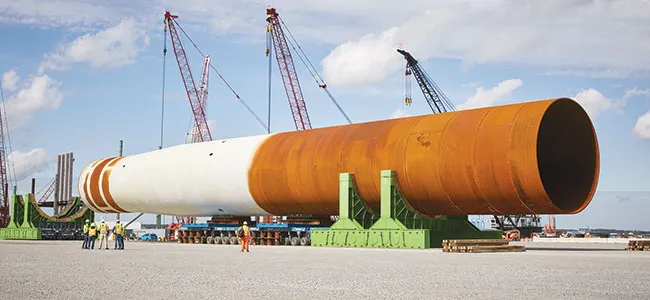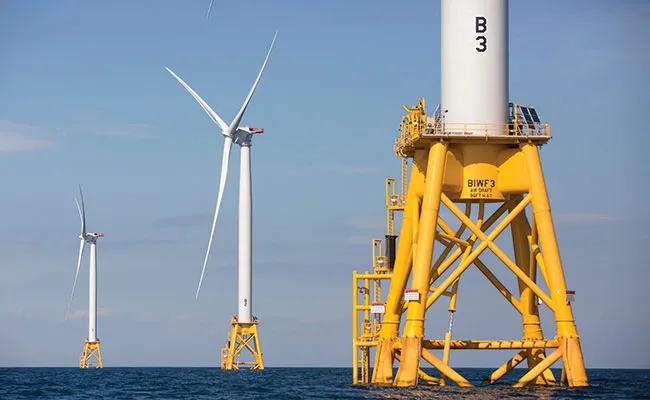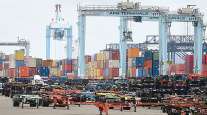Senior Reporter
Port Leaders Push Wind Power as Long-Term Solution

[Stay on top of transportation news: Get TTNews in your inbox.]
AURORA, Colo. — The U.S. Department of Energy’s National Renewable Energy Laboratory says offshore U.S. wind energy production has the potential to produce 2.8 terawatts of electricity, enough energy to power an estimated 350 million homes, easily surpassing the 144 million housing units now in the country.
Global port leaders believe they are part of the solution to capturing this virtually untapped source of renewable energy off of their coasts and under their operation with giant, deep-water wind turbines that float on the water, not unlike floating oil platforms and others that are anchored to the ocean floor with mooring lines.
Port officials discussed the future of offshore energy production and their role in this growing segment at the American Association of Port Authorities’ annual convention Oct. 25.
“We’re currently upgrading the Portsmouth Marine Terminal, which is about a 270-acre terminal to be an offshore wind hub for the mid-Atlantic,” Port of Virginia Chief Development Officer Cathie Vick said during a panel discussion. “We have 176 turbines being installed off the coast of Virginia. It’s about 24 nautical miles offshore.”
The former container terminal is undergoing a $220 million makeover so that it can handle larger, 250-foot-long blades and much heavier components. On average 1,500 tons of materials are used in the construction of wind turbines.
The Port of Virginia has a strategic partnership in place with electric provider Dominion Energy as part of the utility’s Coastal Virginia Offshore Wind project.

Components for Dominion Energy’s Coastal Virginia Offshore Wind project at Portsmouth Marine Terminal. (Port of Virginia via Facebook)
The White House has set a goal of producing 30 gigawatts of power by offshore wind by 2030, which would provide energy for an estimated 21 million homes. But the governors of six Northeastern states are warning these projects need additional federal funding and planning help to ensure the energy-generating systems can get built.
The Biden administration has announced 18 offshore wind shipbuilding projects and nearly $3.5 billion in spending for 12 manufacturing facilities at 13 ports to get the program started.
“There is more money than ever before for port infrastructure under the bipartisan infrastructure law, the Inflation Reduction Act and the Harbor Maintenance Trust Fund," said Ian Gansler, AAPA manager of energy, resilience and sustainability.
Gansler continued, “Federal funding for ports has grown by about 400% from 2014 to 2023. But the fact remains, according to the National Renewable Energy Laboratory, to reach that goal of 30 gigawatts of offshore wind by 2030, we’re short $8 billion for port infrastructure. We need to find new, creative ways to get this money. That includes other grant programs that port authorities have never considered and competed for, and continue working with private partners.”
The Port of Virginia is making progress in its effort to become the primary logistics center for the Mid-Atlantic’s growing offshore-wind energy industry as the port today debuted the first shipment of components for @DominionEnergy's CVOW project at Portsmouth Marine Terminal. pic.twitter.com/kZunKOOy7z — The Port of Virginia (@PortofVirginia) October 27, 2023
But it is not a straight line to success in creating those public-private partnerships, and one private sector company has pulled back its involvement.
Danish wind industry firm Ørsted said it is scrapping plans for a multibillion-dollar wind farm off the New Jersey coast. The company cited supply chain issues, rising construction costs, higher interest rates and lack of federal resources.

Hardy
David Hardy, Ørsted CEO of North American Operations, said, “Without federal action, offshore wind deployment in the U.S. is at serious risk of stalling because states’ ratepayers may be unable to absorb these significant new costs alone.”
The governors of New Jersey, New York, Connecticut, Maryland, Massachusetts and Rhode Island wrote to President Joe Biden on Sept. 15 urging more federal money and permitting reform to speed up a process that can takes years to complete.
While the panelists admit the industry faces growing pains, in California, the state has an ambitious blueprint that points to offshore wind farms producing 25 gigawatts of electricity by 2045, powering 25 million homes and providing about 13% of the power supply.

Three wind turbines stand in the water off Block Island, R.I., the nation's first offshore wind farm. (Michael Dwyer/Associated Press)
Rob Holmlund is the development director for the Humboldt Bay Harbor, Recreation and Conservation District, which is developing a floating wind farm with hundreds of giant turbines, each about 900 feet tall.
“The United Kingdom is all in on this, in Scotland, the North Sea, all of Scandinavia, China, Australia. This is a worldwide shift, not just a U.S. shift, and the state of California has made a pledge to do this, and offshore wind is part of that portfolio,” Holmlund said.
AAPA’s Gansler said that, ultimately, this type of energy is a job-creating machine and good for ports in the long run.
“You can say this is expensive and it is complicated, but then you would just be giving up and missing a tremendous economic opportunity,” Gansler said. “This is a cutting-edge industry, and if we invest in this now, there will be tens of thousands of Americans working in a high-tech, high-paying industry.”
Want more news? Listen to today's daily briefing below or go here for more info:




